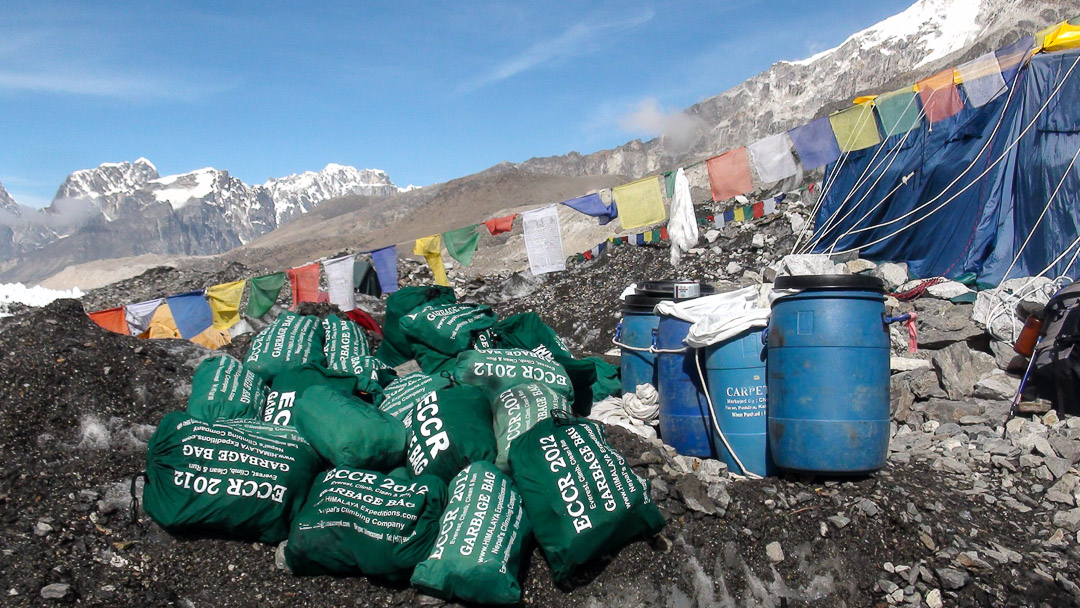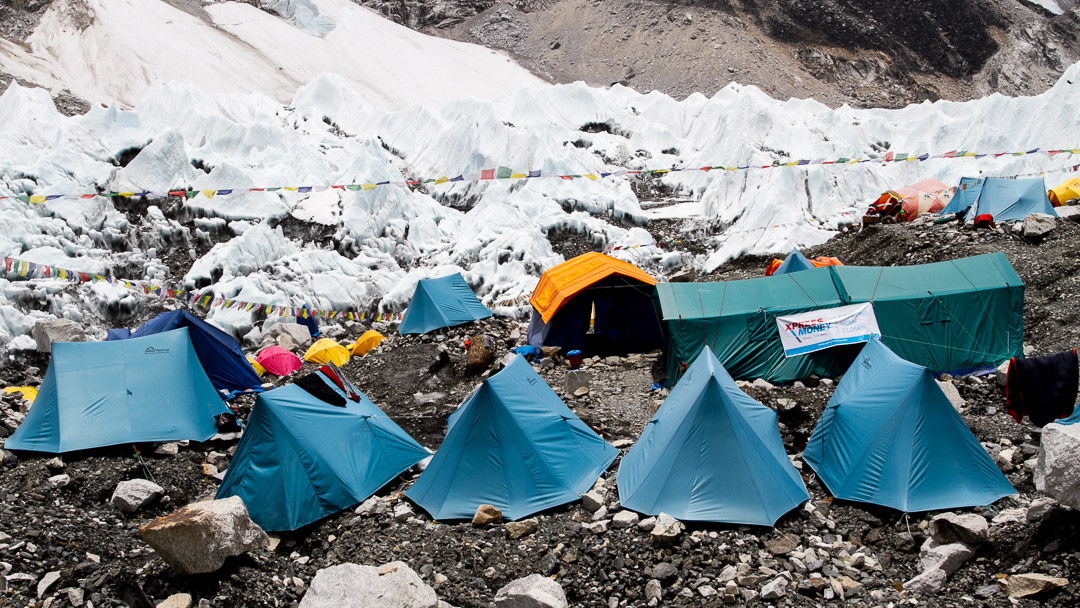
“Tourism is the golden bird that fouls its own nest”. Like the phenomenon we humans like to call ‘development’, tourism too brings in unwanted but inevitable baggages along with it. The statement captures the excrement and other pollution situation in Mount Everest perfectly.
With tourists, came so called ‘development’ which is always accompanied by mismanagement of natural resources and ensuing pollution. Mount Everest and the mountains in the Everest region could not make an exception. Feeding, housing and supplying over 35,000 trekkers, mountaineers, plus a few thousands more seasonal crew came with a price of polluting Mount Everest for many generations to come, until and unless we do something from today onwards. But with no waste management system in the town, the pollution concerning all the supplies and human excrements started piling up and now has flooded the area. Independent trekkers, trekking group, climbers scaling Everest and the government, all of them are equally responsible for degrading Everest region.
Apart from the trekking trail, Mount Everest itself; the Everest base camp and above; get more polluted every year at an increasing rate. Even though, the Everest Base Camp trekking route receives more waste than Mount Everest, the trekking trail is more accessible and people can manage wastes, unlike the mountains, especially Mount Everest in this case. It is idiosyncratic that the sacred sites had more dirt on it than the path that led up to it.
Reasons for pollution on Mount Everest

1. Genuine Reason:
Poor waste management – plastics, papers, cans, tents, burners, oxygen cylinders and other trash have covered the climbing routes and camps. ‘Leave nothing behind’ is a concept simply dismissed as impractical for good reasons. Given all the dangers and ever present harsh conditions, it’s logical to focus on climbing and safety only but given the multiple decades we had, it not an excuse now. Food packages, food wastes, human excrements, oxygen cylinders, ropes & other gears, bodies of deceased makeup for most of the pollutants in Everest region. Only strict enforced system of laws and practices can manage the waste to provide relief.
2. Dirty Reason:
Human fecal waste in five camps between the height of 5,300 meters and 8,848 meters is making its own Everest, as more than 700 climbers and guides spend nearly two months on Everest’s slopes where toilets are not available. So digging a hole is the best option climbers think of in that altitude. This has also resulted in a completely new and disgusting ingredient for glaciers that feed the rivers downstream.
3. Shameful Reason:
More than 200 corpse have become the landmarks of Everest. Removing landmarks will obviously confuse the mountaineers but Everest and dead people both deserve some respect.
4. Surprising Reason:
Traffic jam! Yes, Everest faces traffic jam that causes trouble. Only some months are favorable for climbing and mountaineers from all areas are bound to come at the same time. The path is small and the climbers many. During such a scenario, climbers run out of bottled oxygen and collapse. They push upward long after a sensible turnaround deadline and end up descending into the dark. In the best cases, they leave more oxygen cylinders in the slopes while, in the worst case scenario, they leave themselves.
5. Stupid Reason:
Climbers come to conquer Mt. Everest without enough training at high altitude. Some climbers are unable to judge their own fitness and don’t know when to turn around. Sometimes climbers do not respect the knowledge and experience of guides. This brings death and the climbers become another landmark on the route to Everest. It’s not the mountain’s harshness that kills climbers but their own hubris.
Also, it is better not to climb Mount Everest if you can’t invest enough time and money for the endeavor. Everest is there and will be there, so first, make enough money that will buy you experienced guides, porters and proper equipment to keep yourself safe. Don’t rush.
6. Affluent Reason:
Most of today’s Mountaineers and Everesters (people who intend to climb Everest only) have made significant ‘progress’ from the golden generation of Hillary, Messner, Band, Herzog and many more. Besides the strict philosophy of fitness, discipline, technique and ethics, the new generation has added ‘chill-out’ on the old list. Everest Base Camp now has no shortage of gas heaters, flat-screen tv, Satellite T.V, Tented Pubs with all kinds of alcoholic beverages, and many more symptoms of ‘Joie De Vivre’. The leftovers also become new ingredients of modern day glaciers and the Himalayas.
Efforts to Manage Waste in Everest Region

The National Park and local communities with various external supports have made genuine efforts to get rid of Everest pollution. The known solutions have not been economically feasible and practical. Transportation of solid and human wastes on the back of a porter, pack animal or a helicopter are the only available options so far. You don’t need to be a genius to predict its feasibility.
The government mandates a refundable deposit fee to all Expedition/Climbing groups. All items that could create wastes are weighed and expected wastes are calculated. Depending on the amount of wastes each group brings back, all or a portion of the deposits are rebated by the government. So far, it has been a good policy to encourage proper waste management. The fee varies from US$ 4,000 for Everest to US$ 250 for a 6,000m peak.
Despite all the difficulties, there are institutions and people dedicated to managing wastes and pollution. Sagarmatha Pollution Control Committee (SPCC) was founded in 1991 by multiple interest groups: The Government, National Park, Local Communities, among many others. The name itself defines its primary goals. It is SPCC who collects as much garbage as possible from Everest base camp and basecamp of other mountains after the end of each climbing season, they clean up the trekking trails as well. Many solid waste disposal wooden bins seen in EBC trail were installed by SPCC with assistance from the locals and the wood used were taken from the tree fell by a wind storm. Wastes leftover from various events: religious, social, commercial, etc are also collected and disposed of by SPCC for a certain fee.
Similarly, Namche Youth Club has also been active in waste management. All non-biodegradable wastes generated by daily consumption of thousands of tourists and locals are collected and safely incinerated in a purpose-built pit.
Fortunately, managing waste and controlling pollution have now crept up to be a high priority issue and solutions are being genuinely sought. Many good ideas are now being attempted besides the old self-evident ones.
Eco Everest Expeditions is one of few good examples of efforts made by private tourism companies who have active, long-term and vested interest in keeping Everest region clean beside making profit. Besides, if cleaning up can somehow be made into a part of a profit making venture, that would be the most effective, self-managed and sustainable solution to the problem. The annual event, Eco Everest Expedition have managed to encourage paid-climbers to bring garbage down to basecamp. Mountaineers too seem happy to pay to be part of an expedition that not only targets the summit but has also cleaned up more than 14,250 Kgs of garbage from the slopes of Mount Everest since 2008. There are many other campaigns dedicated for Everest cleaning like Extreme Everest Expedition 2010, Saving Mount Everest Project 2011/12 and Save Mount Everest Campaign etc. Everest Summiteer Association has been working for cleaning the Mount Everest. Apa Sherpa, who holds the world record of scaling the highest peak in the world for the 21st time, has also begun working on the project of cleaning Mount Everest. Efforts are been made, but still Everest is dirty.
Other such efforts include Everest Climb Clean & Run (ECCR) by Tenzing-Hillary Everest Marathon. ECCR requests all participants to carry a little bag of garbage from Starting Point to Finishing Point. Bags are provided by the Marathon team and the response has been positive. A runner may carry less than a kilo but such efforts raise awareness and inspire people to make efforts in their own way to keep Everest clean. Similarly, trekking and climbing operators have begun selling packages where each individual are asked to carry along the solid wastes generated by themselves to a point where they can be safely disposed of.
Biodegradable Hemp plastic bags to collect excretion is one of the merchandise being considered by many relevant companies. The bags are meant to be carried down to Everest base camp from where local disposal team takes over.
The efforts discussed above are highly encouraging and the momentum generated could very well lead to a perfect solution eventually. When private profit-seeking companies are gaining confidence to ask their paying clients to carry their own excrements, its a good sign of things to come.







